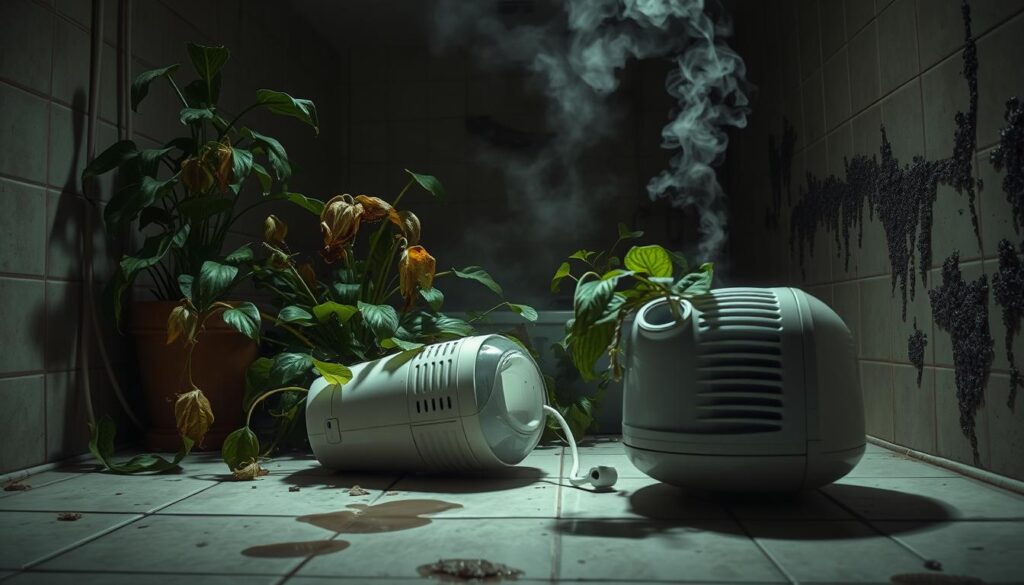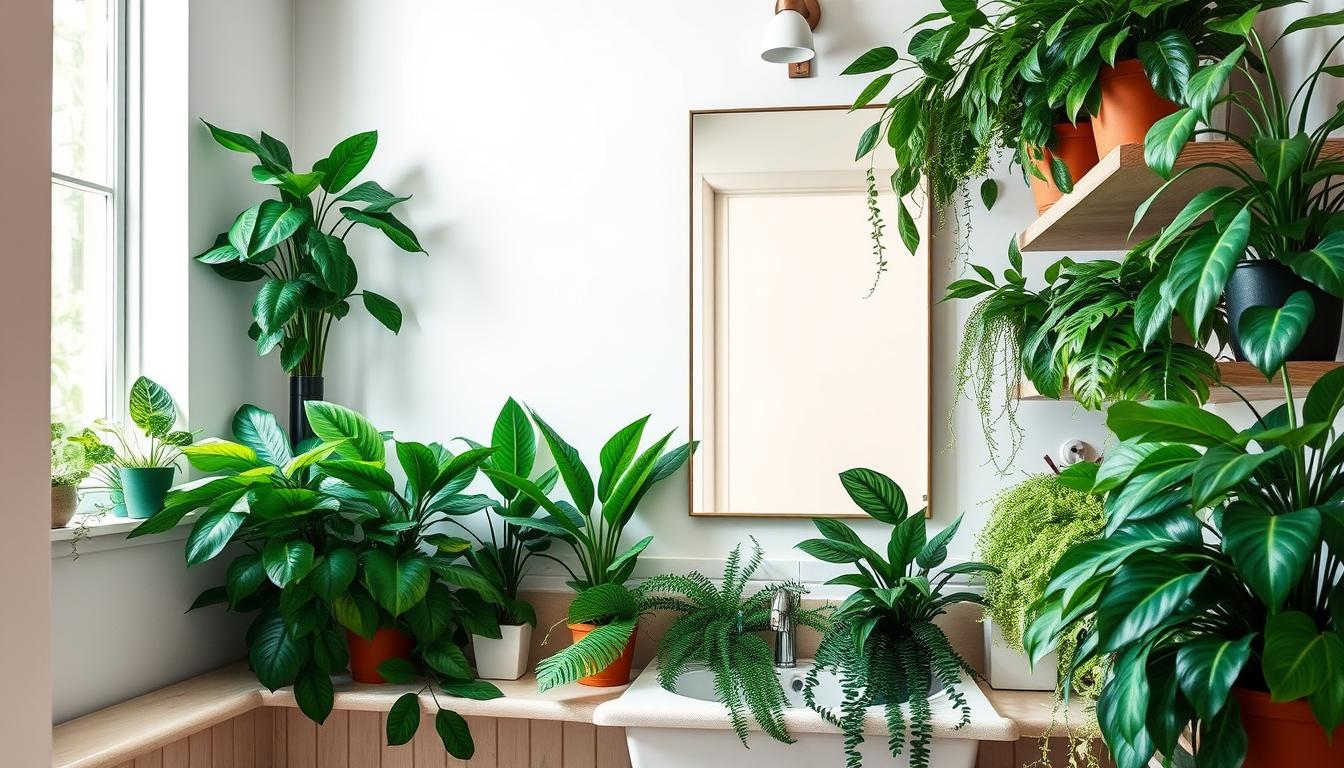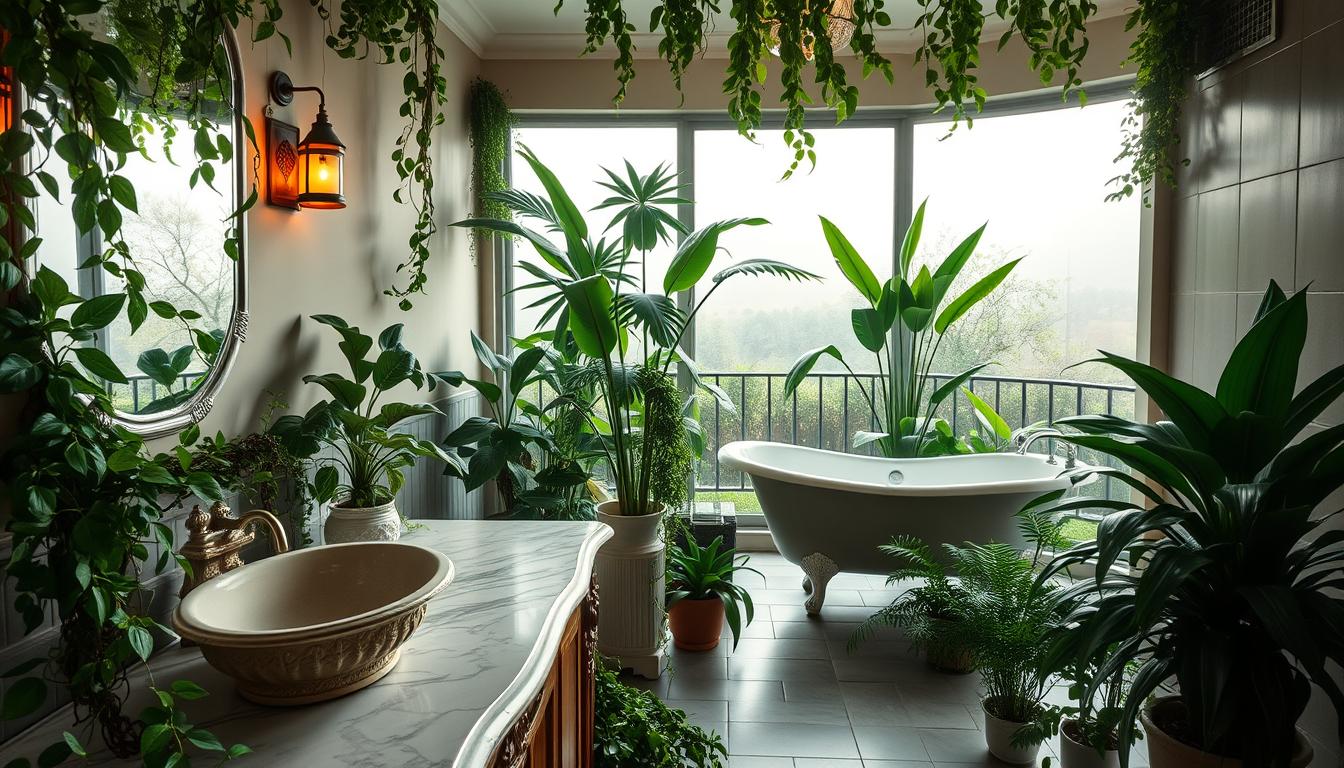When it comes to caring for bathroom plants, controlling humidity is key. Bathrooms are naturally humid, which is great for certain plants. Picking suitable species and setting the right environment are important steps. Knowing how humidity affects plant health makes your space look better. It also helps create a healthy ecosystem. This guide will tell you how to match bathroom plants with the right humidity practices for thriving indoor gardens.
The Importance of Humidity in Bathroom Plant Care
Bathroom plants grow better when they understand the role of humidity. Bathrooms have higher humidity because of showers and baths. This makes them perfect for certain plants that like moisture. Knowing the right level of humidity helps plants stay healthy.
Understanding Humidity Levels
Humidity between 50% and 70% is best for bathroom plants. This helps them breathe and eat properly. Too little humidity makes leaves dry out and turn brown. Use a hygrometer to check the humidity and keep your plants happy.
Effects of Humidity on Plant Health
The right humidity keeps plants healthy. It lowers the chance of mold and mildew, which can hurt plants. When there’s not enough humidity, plants can suffer, showing curled leaves and slow growth. Plants like peace lilies and ferns love the moisture in bathrooms. Knowing about humidity and plants leads to a great indoor garden.
Choosing the Right Plants for High Humidity
Picking the right plants for your bathroom can make it look lush and vibrant. The space benefits from high humidity. Choose plants that love moisture, look good, and improve air quality.
Top Bathroom Plants for Humidity Control
Here are some top plants for humid conditions:
- Peace Lily: This plant cleans the air and handles different light well.
- Boston Fern: Its feathery fronds keep moisture, making it perfect for humid places.
- Spider Plant: Tough and pretty, it also cleans the air.
Plants That Thrive in Moist Environments
For bathroom plants, pick those that do well in wet areas. Some good choices are:
- Philodendron: It adapts to light levels and needs regular watering.
- Cast Iron Plant: Hardy and low-maintenance, it loves humid areas.
- Chinese Evergreen: It has beautiful leaves, loves humidity, and is easy to look after.
Incorporating Humidity Control in Bathroom Plant Maintenance Routines
Keeping your bathroom plants happy means managing humidity well. You need a good plan that includes watering right and using things that help make more moisture. With these steps, you can help your plants grow strong and avoid problems.
Regular Watering Practices
Watering your plants the right way is key. You should get to know what each plant needs. Here are a few tips:
- Check the soil often to know when it’s time to water.
- Water well until the extra water flows out, so roots aren’t wet all the time.
- Use water that’s at room temp to keep your plants from getting shocked.
These steps will help you keep the soil moist, which is what plants need in a humid bathroom.
Using Humidity-Boosting Accessories
Humidity helpers make the air better for your plants. You can use different tools to keep the moisture right. Try these ideas:
- Humidity trays: Put water and small stones in shallow trays. As the water goes into the air, it makes more humidity.
- Misting equipment: Spraying water in the air helps, especially when it’s dry.
- Plants groupings: Putting plants together makes a mini humid area.
Using these tools can make your plants happier. It also makes your bathroom look nicer.
Creating an Ideal Bathroom Environment for Plants
Creating a perfect bathroom for your plants is important. This section looks at the light they need and the best temperatures. With this info, you can make a great space for plants to grow well.
Optimal Light Conditions
Light is very important for plants in your bathroom. They usually like light that’s not too bright. You can do this by:
- Putting plants by windows with soft light.
- Using light curtains to soften bright sunlight.
- Adding fake grow lights if your bathroom is dark.
If your plants don’t get enough light, they might not be healthy. Make sure to check if they’re getting the light they need.
Temperature Considerations
Plants in your bathroom like a steady temperature. They do best in warmth between 65°F and 75°F (18°C to 24°C). Here’s how you can keep the temperature right:
- Don’t put plants where it’s too drafty or too hot.
- Watch out for big temperature changes, especially with the seasons.
- Use a thermometer to keep track of the temperature.
Looking after the light and temperature helps your plants a lot. With the right setup, they can really shine in your bathroom.
Understanding the Role of Air Circulation
Air circulation is key to keeping bathroom humidity in check. It cuts down on too much moisture and stops mold growth. Using exhaust fans boosts airflow and keeps the area well-ventilated.
Benefits of Using Exhaust Fans
Exhaust fans offer many benefits in bathrooms. They pull out damp air, reducing mold and mildew risk. This ventilation makes the space more comfortable and healthier for plants. Exhaust fans also keep the temperature balanced, helping plants grow well.
Promoting Proper Airflow with Plant Placement
Positioning plants smartly can improve airflow in a bathroom. When plants are grouped, they create areas of humidity good for them and the bathroom’s air. This process raises humidity right where it’s needed and boosts air movement around plants. Keeping plants well-spaced allows for free air flow, leading to better growth and moisture control.
Implementing Watering Techniques for Humidity Management
Effective watering plays a big role in managing humidity for plant care. Knowing how to water plants in humid environments is key to avoid overwatering. Following the right practices helps plants grow strong and look vibrant.
Best Watering Practices for Humid Conditions
To water properly in high humidity, think about how often and how you water. Here’s what to do:
- Change how often you water based on the season and soil moisture.
- Use bottom watering so plants can soak up water better.
- Use a moisture meter to check soil wetness and water only when needed.
- Water in the morning to cut down on evaporation and help plants absorb more water.
Avoiding Overwatering in High Humidity
To avoid overwatering in humid places like bathrooms, try these tips:
- Make sure pots have holes for extra water to drain.
- Watch your plant’s growth and adjust how often you water accordingly.
- Choose potting mixes that don’t hold too much water for better drainage.
- Look out for root rot signs, like leaves turning yellow or a soft base.
The Benefits of Plant Showers for Humidity Control
Adding plant showers to your care routine boosts humidity control in your bathroom. It’s a straightforward way to hydrate your plants. It cleans their leaves too, which helps them do better photosynthesis. Knowing the right way to shower your plants will make sure they do well in the moist surroundings you’ve made.
How to Properly Shower Your Plants
Following the right watering methods is key to getting the best from plant showers:
- Use lukewarm water to avoid shocking your plants.
- Set the spray nozzle to a gentle mist to prevent damage to delicate leaves.
- Thoroughly wet the foliage, allowing the water to coat the leaves without flooding the soil.
- Consider using a showerhead attachment for out-of-reach plants, ensuring an even coverage.
Frequency and Timing Considerations
Knowing how often to shower your plants is key for great humidity control. Start by showering your plants every two to four weeks. You might need to adjust this based on the season, such as:
- Increasing the frequency during dryer months.
- Reducing showers during high humidity seasons.
- Watering your plants early in the day to allow excess moisture to evaporate by night.
Using Humidity Trays and Misting
Effectively managing humidity boosts plant care in bathrooms. Humidity trays and misting can raise the moisture levels. These methods make the perfect microenvironment for plants, meeting their specific humidity needs.
Creating Humidity Trays for Your Plants
Humidity trays are a straightforward solution for moisture. Here’s how to make one:
- Select a shallow tray and fill it with pebbles or gravel.
- Add water to the tray, but keep the pebbles above water.
- Place your plants on top, which lets evaporation help the air’s moisture.
This approach makes the area around your plants better for growth by increasing humidity.
Advantages of Regular Misting
Misting provides a quick moisture lift for moisture-loving plants. With a water-filled spray bottle, lightly mist the leaves when needed. This method has several pluses:
- It brings immediate moisture to the leaves.
- It hydrates plants without making the soil too wet.
- It keeps dust off, helping leaves absorb sunlight.
Regular misting can really help your plant care routine, letting your green friends thrive in a moist area.
Common Challenges in Maintaining Humidity
Keeping the right humidity for bathroom plants can be tricky. Changes in the seasons can really impact plant health. Spotting and fixing these issues early helps keep your plants healthy.
Addressing Humidity Fluctuations
Changes in humidity can stress plants, leading to problems like droopy leaves or slow growth. To handle these changes, here are some tips:
- Monitor humidity levels regularly with a hygrometer.
- Use a humidifier during dry seasons to maintain consistent moisture.
- Group plants together to create a microenvironment that retains moisture.
Preventing Mold and Mildew Growth
Too much humidity can cause mold and mildew, which are bad for plants. Here’s how to prevent that:
- Ensure good air flow around your plants.
- Avoid giving them too much water, which can hold too much moisture.
- Check your plants often for signs of mildew, like discolored leaves.

Conclusion
Keeping the right humidity level is key for healthy bathroom plants. Knowing what each plant needs helps them grow better. This balance makes your bathroom look and feel nicer, too.
Water your plants regularly and put them in the right spots to use humidity well. Taking care of light and air flow helps your plants do well in their humid home. This can make your bathroom a beautiful green space.
Getting into growing bathroom plants shows how humidity care makes them stronger. Now’s the time to make your bathroom a plant paradise. Enjoy the looks and the health perks of having well-kept plants.



